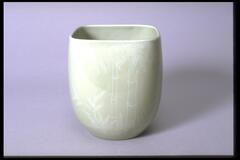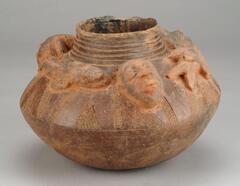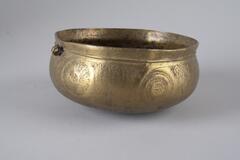14 UMMA Objects
14 UMMA Objects
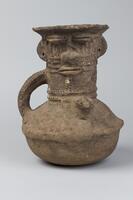
Yoruba (Yoruba (culture or style))
Vessel
1890 – 1920
Gift of Dr. James and Vivian Curtis
2000/2.111
![Flared base with rounded food storage bowl on top. The base is cut with evenly spaced rectangular holes. The lid is incised with a repeating herringbone, or dotted design. The know on the lid is the shape of a Buddhist canopy, or chattra.<br />
<br />
This is a dark blue-gray, high-fired stoneware lidded stem cup. The lid is crowned by a pearl-shaped knob, while both the inner and outer surfaces of lid have traces related to the attachment of the knob to the lid. A v-shaped pattern of engraved dots, made using a sixtooth comb, surrounds the central knob. The cup’s flange slopes inwards and has a sharp edge. The cup body has a horizontal gallery that holds the lid in place. The stem is perforated by rectangular openings, below which is a sharply protruding circular raised band. Traces of rotation and water smoothing are visible on the body and stem of the cup.
<p>[Korean Collection, University of Michigan Museum of Art (2017) p. 59]</p>
Flared base with rounded food storage bowl on top. The base is cut with evenly spaced rectangular holes. The lid is incised with a repeating herringbone, or dotted design. The know on the lid is the shape of a Buddhist canopy, or chattra.<br />
<br />
This is a dark blue-gray, high-fired stoneware lidded stem cup. The lid is crowned by a pearl-shaped knob, while both the inner and outer surfaces of lid have traces related to the attachment of the knob to the lid. A v-shaped pattern of engraved dots, made using a sixtooth comb, surrounds the central knob. The cup’s flange slopes inwards and has a sharp edge. The cup body has a horizontal gallery that holds the lid in place. The stem is perforated by rectangular openings, below which is a sharply protruding circular raised band. Traces of rotation and water smoothing are visible on the body and stem of the cup.
<p>[Korean Collection, University of Michigan Museum of Art (2017) p. 59]</p>](/media/W1siZiIsIjIwMjIvMDkvMjQvOTRoajlpcWRqbV9kZWZhdWx0LmpwZyJdLFsicCIsInRodW1iIiwiMjQweDIwMCJdXQ?sha=27b6314c0d4219a2)
Korean (Korean (culture or style))
Pedestal Bowl with Cover
5th century
Gift of Bruce and Inta Hasenkamp and Museum purchase made possible by Elder and Mrs. Sang-Yong Nam
2004/1.169A&B
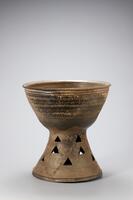
Korean (Korean (culture or style))
Large Pedestal Bowl or Stand
5th century
Gift of Bruce and Inta Hasenkamp and Museum purchase made possible by Elder and Mrs. Sang-Yong Nam
2004/1.179
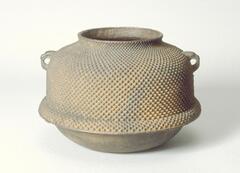
Japanese (Japanese (culture or style))
Kettle—Used in Tea Ceremony
Bequest of Margaret Watson Parker
1955/1.175
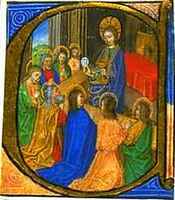
Dutch
Christ giving communion to the Apostles in an historiated initial "C"
1440 – 1460
Museum Purchase
1968/2.44
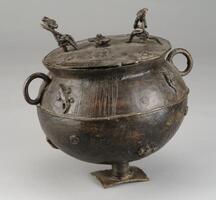
Akan (Akan (culture or style))
Vessel Lid
19th century
Gift of Susan B. and John F. Ullrich
1998/1.123B
![This relatively flat bowl with slightly inward-flaring upright mouth has a protuberant rim to support the lid. The long and astragal-shaped foot is divided into two section, each bearing three square openworks at parallel position. The tip of the foot is long and slightly everted.<br />
<br />
This is a dark gray, high-fired stoneware lidded stem cup. There is knob atop of the lid, around which are a diagonal lines of dots. Below is also the same diagonal dotted lines but in an opposite direction. The cup is relatively shallow and partially dark brown in color. The pedestal is divided into upper and lower sections by a central raised band formed by two shallow incised horizontal lines. Three rectangular perforations in the upper section are vertically aligned with those of the lower section.
<p>[Korean Collection, University of Michigan Museum of Art (2017) p. 60]</p>
This relatively flat bowl with slightly inward-flaring upright mouth has a protuberant rim to support the lid. The long and astragal-shaped foot is divided into two section, each bearing three square openworks at parallel position. The tip of the foot is long and slightly everted.<br />
<br />
This is a dark gray, high-fired stoneware lidded stem cup. There is knob atop of the lid, around which are a diagonal lines of dots. Below is also the same diagonal dotted lines but in an opposite direction. The cup is relatively shallow and partially dark brown in color. The pedestal is divided into upper and lower sections by a central raised band formed by two shallow incised horizontal lines. Three rectangular perforations in the upper section are vertically aligned with those of the lower section.
<p>[Korean Collection, University of Michigan Museum of Art (2017) p. 60]</p>](/media/W1siZiIsIjIwMjIvMDkvMjQvNXE2djZzeXFpMV9kZWZhdWx0LmpwZyJdLFsicCIsInRodW1iIiwiMjQweDIwMCJdXQ?sha=375714bda7bdd8b2)
Korean (Korean (culture or style))
Footed Shallow Bowl
5th century
Gift of Bruce and Inta Hasenkamp and Museum purchase made possible by Elder and Mrs. Sang-Yong Nam
2004/1.165A&B
![This grayish-blue stoneware jar has a globular body, round base and straight elongated neck. A little wide single ridges encircle the middle of the neck, dividing it into three sections, each engraved with a wave pattern. The base has two ridges encircled on the below part and triangular holes.<br />
<br />
This vessel was fired as a long-necked jar attached to the top of a bowl-shaped pedestal. The surfaces of the jar and pedestal display traces of natural glaze that was formed on the surface or flowed downwards. The long and slightly splayed neck of the jar is divided into three sections by raised bands, while each section is decorated with wave designs. The bowlshaped pedestal has a very shallow bowl section and a grooved edge. The pedestal has a flared profile and features triangular perforations in five places. Two raised bands surround the area below the perforations.
<p>[Korean Collection, University of Michigan Museum of Art (2017) p. 56]</p>
<br />
This grayish-blue stoneware jar has a globular body, round base and straight elongated neck. A little wide single ridges encircle the middle of the neck, dividing it into three sections, each engraved with a wave pattern. The base has two ridges encircled on the below part and triangular holes.<br />
<br />
This vessel was fired as a long-necked jar attached to the top of a bowl-shaped pedestal. The surfaces of the jar and pedestal display traces of natural glaze that was formed on the surface or flowed downwards. The long and slightly splayed neck of the jar is divided into three sections by raised bands, while each section is decorated with wave designs. The bowlshaped pedestal has a very shallow bowl section and a grooved edge. The pedestal has a flared profile and features triangular perforations in five places. Two raised bands surround the area below the perforations.
<p>[Korean Collection, University of Michigan Museum of Art (2017) p. 56]</p>
<br />
](/media/W1siZiIsIjIwMjIvMDkvMjQvNWxqNjZqOXo5Nl9kZWZhdWx0LmpwZyJdLFsicCIsInRodW1iIiwiMjQweDIwMCJdXQ?sha=4b649beab0e8b4a1)
Korean (Korean (culture or style))
Round-bottomed jar with cover, fused to low ceremonial stand
5th century
Gift of Bruce and Inta Hasenkamp and Museum purchase made possible by Elder and Mrs. Sang-Yong Nam
2004/1.167A&B
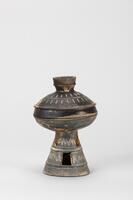
Korean (Korean (culture or style))
Pedestal Bowl with Cover
5th century
Gift of Bruce and Inta Hasenkamp and Museum purchase made possible by Elder and Mrs. Sang-Yong Nam
2004/1.168A&B
Loading…
